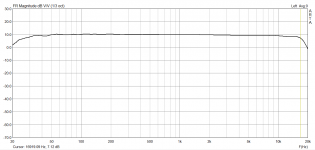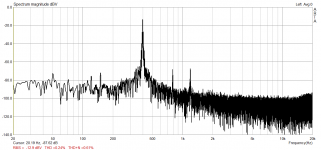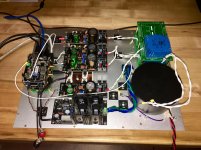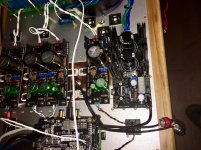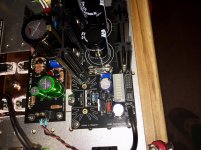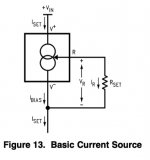That makes this cassette tape recorder a 'player' only... what about the magnificent analogue recording feature...?
The recording is doing well after careful adjustments of all things adjustable. Here are my response and THD measurements of newly recorded pink noise and 400Hz sine tone at -5 panel meter level. The deck's 0dB ref level is 400mV output i.e. -8dBV. Cassette TDK SA, high bias (CrO2), N.R off.
Attachments
hi there, following you and very interested in a GB if this comes. (for my RPi3+Kali+Piano thinking to move to digiOne)
GB Thread started. May modify first post as needed, no current close date set. There are still several boards out in the wild that we are waiting for feedback on.
https://www.diyaudio.com/forums/group-buys/338109-gb-salas-adapter-board.html#post5796161
This looks like it could power my audio PC. Max power would be 19V 120 Watts. That works out to just under 6.5 amp.
What's the risk of over voltage caused by a failed component? I only ask because I bought one of the high current kits on Ebay and when I shared the board pics some cautioned me that should a regulator fail it would send all that extra voltage to the PC and fry god knows what
What's the risk of over voltage caused by a failed component? I only ask because I bought one of the high current kits on Ebay and when I shared the board pics some cautioned me that should a regulator fail it would send all that extra voltage to the PC and fry god knows what
Last edited:
This one has three series elements. The fuse, the TO-3P big transistor, its TO-220 helper transistor. The output should go to zero when something's broken in all those cases. Breaking the fuse on a fault it is obvious what will happen, I had also seen the helper transistor getting broken first by an output short in a similar architecture PSU (DCSTB for DCG3) and the output went to zero while the main one survived, the big one if broken should kill the helper too.
This is a more or less 100W capable supply when externally well sinked. I would recommend the higher SOA NJW1302G in your case as TO-3P main transistor. Also, as high mF 35V reservoir capacitors as they can fit in, 200VA 20V transformer of paralleled secondaries, and 12A or > bridge diodes.
This is a more or less 100W capable supply when externally well sinked. I would recommend the higher SOA NJW1302G in your case as TO-3P main transistor. Also, as high mF 35V reservoir capacitors as they can fit in, 200VA 20V transformer of paralleled secondaries, and 12A or > bridge diodes.
Hi Salas,
I've been making similar circuit recently. I'm skeptical about LM334's noise performance, so I try to look for better alternatives. So far, I am using a CRD+2N5458 cascode as CCS to feed the LED strings. However, someone pointed out that CRD could be very noisy, too. What's your opinion about this? Do you think the LM334 is good enough?
I've been making similar circuit recently. I'm skeptical about LM334's noise performance, so I try to look for better alternatives. So far, I am using a CRD+2N5458 cascode as CCS to feed the LED strings. However, someone pointed out that CRD could be very noisy, too. What's your opinion about this? Do you think the LM334 is good enough?
Its good enough when you filter the node but not a benchmark. Depends on the purpose. Here its fine. I would not directly bias an MC phono's input stage FET with it though. Its stable with a wide enough range of voltage across it nonetheless. CRDs are high gos JFETs with G+S internally shorted. High gos (output conductance) isn't usually associated with high gfs (transconductance) which is usually associated with minimal noise.
I would like to use the L-adaptor for my Raspberry Pi. I can get away with less than 1A current draw. Can I use the same bridge diodes as the UBiB, MSF860G as well as skipping the slow blow fuse?
Also, is there sonic improvements using quality reservoir caps like in UBiB?
Yes, those are 8A diodes good for much more powerful apps. From my tests with the RPi 3 I assume you should be able to run them even without sinks for such a low power Pi config. I would recommend 1.5 inch board level sink for the main transistor and a 30-50VA 9V Tx.
Its your choice to skip the fuse, but if you leave it there, it may come handy in a short or something. An 8A Slo Blo has very little resistance, almost as a jumper. You may test what you prefer vs a thick jumper wire soldered under PCB between the fuse holder pins of course.
Because there will be no high ambient temp radiated in your case you can also use 85C reservoirs of your choice. They can even be 25V rated if you are not planning any other voltage use for this PSU that would need any higher than 15V transformer.
Please read about my Beta-exit test for L-adapter PCB and components Kit below.
It will be available via GB from Tea-Bag soon.
Device used to test for integration: Allo Katana DAC with RPi powered from Allo Isolator v1.3.
(Katana Player With Isolator)
Waveshare 4.1” LCD and Seagate 2.5”external HD are also powered from RPi.
Re:loadPro: CC Load (Re:load Pro from Arachnid Labs on Tindie)
L-adapter PCB: Tea-Bag GB PCB
Components: Tea-Bag GB Components kit
Transformer: AnTek-1209 100VA, 2x9V (AS-1209 - 100VA 9V Transformer - AnTek Products Corp)
I assembled it in 20 min. Very easy and self-expiatory. Full assemble did not require usage of any special tools. All info about PCB and its components KIT will be introduced by Tea-Bag very soon. I fired it up with Constant Current (CC) load an ran for about 30 min with 3A CC draw. Then, I ran 10-15 additional min for 4A CC draw. Vout adjusted to 5.08-5.09 VDC (I set bit higher than 5V due to potential losses in feeding cable). It is stabilized within 20 sec. Farther fine Voltage stabilization was related to thermal equilibrium and settled in minutes.
Since my first sanity check ended up very successfully, I integrated L-adapter onto my Katana DAC. Also relatively easy integration and I used 3mm cupper bar connected to the bottom plate of my enclosure as heatsink.
I made two clips on YouTube, but one was removed due to some song copyrights violation. Oops…
Please see one that survived from that links: YouTube
I just finished listening to it via my main system. OMG... it is a huge deference with L-adapter. I invited two of my friends and all of us still remember how it sounded last week with SMPS. We all agreed about huge gain in clarity and micro-details. Absolutely organic presentation subjectively.
It will be available via GB from Tea-Bag soon.
Device used to test for integration: Allo Katana DAC with RPi powered from Allo Isolator v1.3.
(Katana Player With Isolator)
Waveshare 4.1” LCD and Seagate 2.5”external HD are also powered from RPi.
Re:loadPro: CC Load (Re:load Pro from Arachnid Labs on Tindie)
L-adapter PCB: Tea-Bag GB PCB
Components: Tea-Bag GB Components kit
Transformer: AnTek-1209 100VA, 2x9V (AS-1209 - 100VA 9V Transformer - AnTek Products Corp)
I assembled it in 20 min. Very easy and self-expiatory. Full assemble did not require usage of any special tools. All info about PCB and its components KIT will be introduced by Tea-Bag very soon. I fired it up with Constant Current (CC) load an ran for about 30 min with 3A CC draw. Then, I ran 10-15 additional min for 4A CC draw. Vout adjusted to 5.08-5.09 VDC (I set bit higher than 5V due to potential losses in feeding cable). It is stabilized within 20 sec. Farther fine Voltage stabilization was related to thermal equilibrium and settled in minutes.
Since my first sanity check ended up very successfully, I integrated L-adapter onto my Katana DAC. Also relatively easy integration and I used 3mm cupper bar connected to the bottom plate of my enclosure as heatsink.
I made two clips on YouTube, but one was removed due to some song copyrights violation. Oops…
Please see one that survived from that links: YouTube
I just finished listening to it via my main system. OMG... it is a huge deference with L-adapter. I invited two of my friends and all of us still remember how it sounded last week with SMPS. We all agreed about huge gain in clarity and micro-details. Absolutely organic presentation subjectively.
Attachments
Looking at post#1schematic diagram i can't see the lm334 pin R connection.
Is it a black&white pcb available for home etching?
Here is the official LM334 diagram for the resistor. Hope this will help.
Attachments
I made two clips on YouTube, but one was removed due to some song copyrights violation. Oops…
Please see one that survived from that links: YouTube
I just finished listening to it via my main system. OMG... it is a huge deference with L-adapter. I invited two of my friends and all of us still remember how it sounded last week with SMPS. We all agreed about huge gain in clarity and micro-details. Absolutely organic presentation subjectively.
Hello Alex, nice result. Congrats. Very good stability for such a simple circuit on your bench DMM too. Not moving before the third decimal digit.
Do you know the average and peak consumption of your Katana stack with Raspberry Pi + LCD & 2.5" Hard Disk?
Also which one type was the previously used SMPS? Was it a common plastic brick or some better quality module?
I can still see a second video that plays muted Bob Dylan (?) by the way: YouTube
Is it a black&white pcb available for home etching?
In official PCB form its not compatible with home etching, because double layer with plated through holes. That did not stop Nikosokey to create a small version at home for his 6V6 tube preamp heaters in post #64 though. With just one 22mF (?) reservoir cap and as few LEDs as he needed for his fixed application.
It is blocked in US.
We want replacement video from the main audio system then, but with extraterrestrial music that YouTube won't know to block
We want replacement video from the main audio system then, but with extraterrestrial music that YouTube won't know to block
Certainly, I’ll shoot such video next weekend when my DAC will be fully assembled. I took front and back panels of it to machine shop for milling. It is impossible to judge SQ from YouTube, but trust my words, it is the best digital sound I ever heard. These power supplies brought this DAC to completely different level and L-adapter is a final touch to that painting. My lab test setup made from simple TDA 7297 amp and restored Pioneer CS-G7001 speakers from 70s. I’ll let you see and hear same song from my main setup: Salas DCG3 pre, Nelson’ F5T monoblocks (real 108W each) and Acoustic Zen Adagio floor standing speakers.
My deepest appreciation to Salas for unbelievable design. Your talent is limitless. Tea-Bag, thank you a lot for such opportunity to touch and taste these devices. Extraordinary quality for all PCBs and parts choices.
Salas vs Salas
Great, Alex, I've listened to your clip via the L-adapter powered Bufallo 9028 DAC. Does the character of the sound change over time ?
My first impressions is that It certainly has more meatier sound. It's just the first hours so in the extreme frequencies things are as expected of a new equipment.
The comparison will be against a Reflektor. I wanted to hear how well it will function as a pre-regulator. So far so good.
Need some further listening, in the meantime I'll setup Tinker which is the main goal
Great, Alex, I've listened to your clip via the L-adapter powered Bufallo 9028 DAC. Does the character of the sound change over time ?
My first impressions is that It certainly has more meatier sound. It's just the first hours so in the extreme frequencies things are as expected of a new equipment.
The comparison will be against a Reflektor. I wanted to hear how well it will function as a pre-regulator. So far so good.
Need some further listening, in the meantime I'll setup Tinker which is the main goal
- Home
- Amplifiers
- Power Supplies
- L-Adapter

